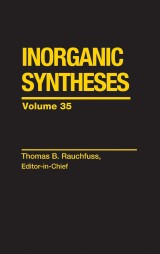Details

Inorganic Syntheses, Volume 35
Inorganic Syntheses, Band 35 1. Aufl.
|
143,99 € |
|
| Verlag: | Wiley |
| Format: | |
| Veröffentl.: | 13.08.2010 |
| ISBN/EAN: | 9780470651544 |
| Sprache: | englisch |
| Anzahl Seiten: | 224 |
DRM-geschütztes eBook, Sie benötigen z.B. Adobe Digital Editions und eine Adobe ID zum Lesen.
Beschreibungen
The Inorganic Syntheses series provides all users of inorganic substances with detailed and foolproof procedures for the preparation of important and timely compounds. <ul> <li>Includes complete, up-to-date procedures involving important inorganic substances</li> <li>Contains subject, contributor, and formula indexes</li> </ul>
Preface. <p>Contributors.</p> <p>Dedication.</p> <p>Notice to Contributors and Checkers.</p> <p>Toxic Substances and Laboratory Hazards.</p> <p>Chapter One COMPLEXES OF BULKY ß-DIKETIMINATE LIGANDS.</p> <p>1. Introduction.</p> <p>2. ß-Diketiminate Precursors HL<sup>Me,Me3</sup> and TlL<sup>Me,Me3</sup> (L<sup>Me,Me3</sup> = 2,4-Bis-(Mesitylimido)Pentyl).</p> <p>3. ß-Diketiminate Precursors L<sup>Me,iPr2</sup>H, [<sup>LMe,iPr2</sup>Li]x, and [L<sup>tBu,iPr2</sup>K]x (L<sup>Me,iPr2</sup> = 2,4-Bis-(2,6-Diisopropylphenylimido)Pentyl; L<sup>tBu,iPr2</sup> = 2,2,6,6-</p> <p>Tetramethyl-3,5-Bis-(2,6-Diisopropylphenylimido)Heptyl).</p> <p>4. ß-Diketiminate Precursors L<sup>tBu,iPr2</sup>H and L<sup>tBu,iPr2</sup>Li(THF) (L<sup>tBu,iPr2</sup>=2,2,6,6-Tetramethyl-3,5- Bis-(2,6-Diisopropylphenylimido)Heptyl).</p> <p>5. Scandium Trichloride Tris(Tetrahydrofuran) and ß-Diketiminate-Supported Scandium Chloride Complexes.</p> <p>6. ß-Diketiminate-Supported Titanium and Vanadium Dichloride Complexes.</p> <p>7. ß-Diketiminate-Supported Vanadium and Chromium Chloride Complexes.</p> <p>8. ß-Diketiminate-Supported Manganese and Zinc Complexes.</p> <p>9. Iron 2,4-Bis-(2,6-Diisopropylphenylimido)Pentyl Chloride (L<sup>Me,iPr2</sup>FeCl).</p> <p>10. Iron 2,2,6,6-Tetramethyl-3,5-Bis-(2,6-Diisopropylphenylimido)Heptyl Chloride (L<sup>tBu,iPr2</sup>FeCl).</p> <p>11. Cobalt 2,2,6,6-Tetramethyl-3,5-Bis-(2,6-Diisopropylphenylimido) Heptyl Chloride (L<sup>tBu,iPr2</sup>CoCl).</p> <p>12. ß-Diketiminate-Supported Nickel(II) and Nickel(I) Complexes of L<sup>Me,Me3</sup> (L<sup>Me,Me3</sup> = 2,4-Bis-(Mesitylimido)Pentyl).</p> <p>13. Nickel 2,4-Bis-(2,6-Diisopropylphenylimido)Pentyl Chloride Dimer, [L<sup>Me,iPr2</sup>Ni(µ-Cl)]<sub>2</sub>.</p> <p>14. Bis[Copper 2,4-Bis-(2,4,6-Trimethylphenylimido)Pentyl] Toluene, (L<sup>Me,Me3</sup>Cu)<sub>2</sub>(µ-n<sup>2</sup>:n<sup>2</sup>-C<sub>7</sub>H<sub>8</sub>).</p> <p>15. Copper 2,4-Bis-(2,6-Diisopropylphenylimido)Pentyl Chloride (L<sup>Me,iPr2</sup>CuCl).</p> <p><b>Chapter Two BORON CLUSTER COMPOUNDS.</b></p> <p>16. Salts of Dodecamethylcarba-<i>closo</i>-Dodecaborate(—) Anion, CB<sub>11</sub>Me<sub>12</sub>, and the Radical Dodecamethylcarba-<i>closo</i>-Dodecaboranyl, CB<sub>11</sub>Me<sub>12</sub>.</p> <p>17. Cesium Dodecahydroxy-<i>closo</i>-Dodecaborate, Cs<sub>2</sub>[B<sub>12</sub>(OH)<sub>12</sub>].</p> <p><b>Chapter Three COORDINATION COMPOUNDS.</b></p> <p>18. Pentaaquanitrosylchromium Sulfate.</p> <p>19. The Tetradentate Bispidine Ligand Dimethyl-(3,7-Dimethyl-9-oxo-2,4-bis(2-pyridyl)-3,7-Diazabicyclo[3.3.1]nonane)-1, 5-dicarboxylate and Its Copper(ll) Complex.</p> <p>20. Tris(2-Picolinyl)Methane and Its Copper(I) Complex.</p> <p><b>Chapter Four CARBENE LIGANDS AND COMPLEXES.</b></p> <p>21. 1,3-Dialkyl-Imidazole-2-Ylidenes.</p> <p>22. A Chelating Rhodium <i>N</i>-Heterocyclic Carbene Complex by Transmetallation from a Silver–NHC Intermediate.</p> <p>23. Rhodium and Iridium <i>N</i>-Heterocyclic Carbene Complexes from Imidazolium Carboxylates.</p> <p><b>Chapter Five FUNCTIONAL LIGANDS AND COMPLEXES.</b></p> <p>24. <i>N</i>-<i>tert</i>-Butyl <i>ortho</i>-Aminophenol, <i>ortho</i>-Iminoquinone, and a Zirconium(IV) bis(Aminophenolate) Complex.</p> <p>25. Synthesis of the Water-Soluble Bidentate (P, N) Ligand PTN(Me) (PTN(Me) = 7-Phospha-3-methyl-1,3,5-triazabicyclo[3.3.1]nonane).</p> <p>26. Synthesis of Metal-Organic Frameworks: MOF-5 and MOF-177.</p> <p><b>Chapter Six ORGANOMETALLIC REAGENTS.</b></p> <p>27. Tricarbonyl 1,3,5-Trimethyl-1,3,5-Triazacyclohexane Complexes of Chromium(0), Molybdenum(0), and Tungsten(0) [M(CO)<sub>3</sub>(Me<sub>3</sub>TACH) (M = Cr, Mo, W)].</p> <p>28. Manganese Tricarbonyl Transfer (MTT) Agents.</p> <p>29. Bis(1,5-Cyclooctadiene)Nickel(0).</p> <p>30. Sodium (n<sup>5</sup>-Cyclopentadienyl)Tris(Dimethylphosphito-<i>P</i>) Cobaltate(III), Na[(C<sub>5</sub>H<sub>5</sub>)Co{P(O)(OMe)<sub>2</sub>}<sub>3</sub>].</p> <p><b>Chapter Seven BIO-INSPIRED IRON AND NICKEL COMPLEXES.</b></p> <p>31. Iron–Cyanocarbonyl Complexes [PPN][Fe(CO)<sub>4</sub>(CN)] and [PPN][FeBr(CO)<sub>3</sub>(CN)<sub>2</sub>].</p> <p>32. Nickel Complexes of Bis(Diethylphosphinomethyl) Methylamine.</p> <p>33. Monomeric Iron(II) Complexes Having Two Sterically Hindered Arylthiolates.</p> <p>34 (1,3-Propanedithiolato)-Hexacarbonyldiiron and Cyanide Derivatives.</p> <p><b>Chapter Eight RUTHENIUM COMPLEXES.</b></p> <p>35. Ruthenium(II)-Chlorido Complexes of Dimethylsulfoxide.</p> <p>36. Synthesis of Chloride-Free Ruthenium(II) Hexaaqua Tosylate, [Ru(H<sub>2</sub>O)<sub>6</sub>]tos<sub>2</sub>.</p> <p>37. Basic Ruthenium Acetate and Mixed Valence Derivatives.</p> <p>38. Di-µ-Chloro(Ethylbenzoate)Diruthenium(II), [(n<sup>6</sup>-etb)RuCl<sub>2</sub>]<sub>2</sub>.</p> <p><b>Chapter Nine IRIDIUM COMPLEXES.</b></p> <p>39. The Diphosphine tfepma and its Diiridium Complex Ir<sub>2</sub><sup>0,II</sup>(tfepma)<sub>3</sub>Cl<sub>2</sub>.</p> <p>40. Heteroleptic Cyclometalated Iridium(III) Complexes.</p> <p>41. Oxygen and Carbon Bound Acetylacetonato Iridium(III) Complexes.</p> <p>Contributor Index.</p> <p>Subject Index.</p> <p>Formula Index.</p>
<p><strong>Thomas Rauchfuss</strong> received his undergraduate degree from the University of Puget Sound (1971) and his Ph.D. from Washington State University (1976). He has studied overseas at the following institutions: the Australian National University, University of Auckland, University of Strasbourg, and the Technical University of Karlsruhe. He is interested in all aspects of the synthesis and reactivity of inorganic, organometallic, and main-group compounds and materials.?He is a winner of the prestigious ACS Award in Inorganic Chemistry, and is Fellow of both the American Chemical Society and the Japan Society for the Promotion of Science.?Among others, Dr. Rauchfuss has held the Guggenheim Fellowship as well as the Alfred P. Sloan Fellowship,and has written numerous papers and book chapters.
Diese Produkte könnten Sie auch interessieren:

Mass Spectrometry of Inorganic and Organometallic Compounds

von: William Henderson, J. Scott McIndoe

59,99 €

Neurodegenerative Diseases and Metal Ions, Volume 1

von: Astrid Sigel, Helmut Sigel, Roland K. O. Sigel

228,99 €














